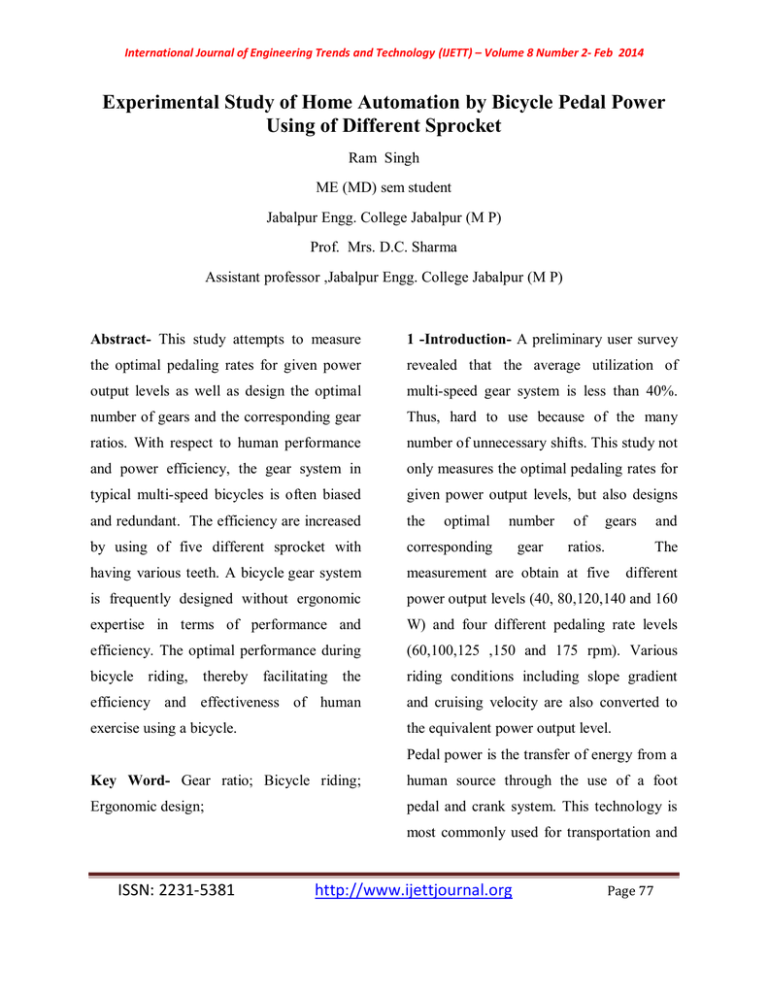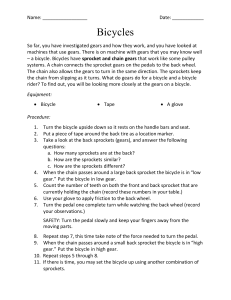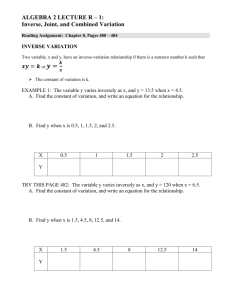Experimental Study of Home Automation by Bicycle Pedal Power
advertisement

International Journal of Engineering Trends and Technology (IJETT) – Volume 8 Number 2- Feb 2014 Experimental Study of Home Automation by Bicycle Pedal Power Using of Different Sprocket Ram Singh ME (MD) sem student Jabalpur Engg. College Jabalpur (M P) Prof. Mrs. D.C. Sharma Assistant professor ,Jabalpur Engg. College Jabalpur (M P) Abstract- This study attempts to measure 1 -Introduction- A preliminary user survey the optimal pedaling rates for given power revealed that the average utilization of output levels as well as design the optimal multi-speed gear system is less than 40%. number of gears and the corresponding gear Thus, hard to use because of the many ratios. With respect to human performance number of unnecessary shifts. This study not and power efficiency, the gear system in only measures the optimal pedaling rates for typical multi-speed bicycles is often biased given power output levels, but also designs and redundant. The efficiency are increased the by using of five different sprocket with corresponding ratios. The having various teeth. A bicycle gear system measurement are obtain at five different is frequently designed without ergonomic power output levels (40, 80,120,140 and 160 expertise in terms of performance and W) and four different pedaling rate levels efficiency. The optimal performance during (60,100,125 ,150 and 175 rpm). Various bicycle riding, thereby facilitating the riding conditions including slope gradient efficiency and effectiveness of human and cruising velocity are also converted to exercise using a bicycle. the equivalent power output level. optimal number gear of gears and Pedal power is the transfer of energy from a Key Word- Gear ratio; Bicycle riding; human source through the use of a foot Ergonomic design; pedal and crank system. This technology is most commonly used for transportation and ISSN: 2231-5381 http://www.ijettjournal.org Page 77 International Journal of Engineering Trends and Technology (IJETT) – Volume 8 Number 2- Feb 2014 has been used to propel bicycles for over a gear in that sprockets are never meshed hundred years. together directly, and differs from a pulley in that sprockets have teeth and pulleys are smooth. Sprockets are used in bicycles, motorcycles, cars, tracked vehicles, and other machinery either to transmit rotary motion between two shafts where gears are unsuitable or to impart linear motion to a track, tape etc. Perhaps the most common form of sprocket may be found in the bicycle, in which the Figure 1.1 - Setup pedal shaft carries a large sprocket-wheel, Less commonly pedal power is used to which drives a chain, which, in turn, drives a power agricultural and hand tools and even small sprocket on the axle of the rear wheel. to generate electricity Sprockets 2- Pedal power- are of various designs, a maximum of efficiency being claimed for Some applications include pedal powered each by its originator. Sprockets typically do laptops, pedal powered grinders and pedal not have a flange. Some sprockets used with powered water wells. Some third world timing belts have flanges to keep the timing development projects currently transform belt centered. Sprockets and chains are also used bicycles into pedal powered tools for used for power transmission from one shaft sustainable development. The articles on this to another where slippage is not admissible, page sprocket chains being used instead of belts are about the many wonderful applications for pedal power technology. or ropes and sprocket-wheels instead of pulleys. They can be run at high speed and 3-Sprocket - The name 'sprocket' applies some forms of chain are so constructed as to generally to any wheel upon which are be noiseless even at high speed. radial projections that engage a chain passing over it. It is distinguished from a ISSN: 2231-5381 http://www.ijettjournal.org Page 78 International Journal of Engineering Trends and Technology (IJETT) – Volume 8 Number 2- Feb 2014 front by the number to the rear gives the 4-Chain number of gear ratios, often called "speeds". Chain types are identified by number; ie. a number 40 chain. The rightmost digit is 0 for chain of the standard dimensions; 1 for lightweight chain; and 5 for roller less bushing chain. The digits to the left indicate the pitch of the chain in eighths of an inch. For example, a number 40 chain would have a pitch of four-eighths of an inch, or 1/2", and would be of the standard dimensions in width, roller diameter, etc. Figure 5.1 - Gearing The roller diameter is "nearest binary fraction" (32nd of an inch) to 5/8ths of the pitch; pin diameter is half of roller diameter. The width of the chain, for "standard" (0 series) chain, is the nearest binary fraction to 5/8ths of the pitch; for narrow chains (1 series) width is 41% of the pitch. Sprocket thickness is approximately 85-90% of the roller width. Hub gears use epicycle gearing and are enclosed within the axle of the rear wheel. Because of the small space, they typically offer fewer different speeds, although at least one has reached 14 gear ratios and Fallbrook Technologies manufactures a transmission with technically infinite ratios. Causes for failure of bicycle gearing include: worn teeth, damage caused by a 5-Gearing faulty chain, damage due to thermal There are several gears available on the rear expansion, broken teeth due to excessive sprocket assembly, attached to the rear pedaling force, interference by foreign wheel. A few more sprockets are usually objects, and loss of lubrication due to added to the front assembly as well. negligence. Multiplying the number of sprocket gears in ISSN: 2231-5381 http://www.ijettjournal.org Page 79 International Journal of Engineering Trends and Technology (IJETT) – Volume 8 Number 2- Feb 2014 6. Control panel Table 2. Sr Power in No. watts Required RPM 1 40 60 2 80 100 3 120 125 4 140 150 5 160 175 Figure 6.1 - Control panel 7.Test and analysis Table 1. List of component Sr Name Specification 1 D.C. motor 25 W 2 Five sprocket 1 no. No. set 3 Pedal set 1 no. 4 Chain 1 no. 5 Mixer Small type 6 D.C. convertor 12v D.C. to 220v Figure 7.1 – Graph 8.Applications A.C. 7 Battery 12v dc 7.2 ah 8 Connection 1mm wire 9 Generator DC type 10 stand 1 no. ISSN: 2231-5381 Table.3 Sr. No. Home Appliances 1 2 Food Grinder Washing Machine Small water pump 3 http://www.ijettjournal.org Required using of 12v dc motor 40 watts 85 watts 45 watts Page 80 International Journal of Engineering Trends and Technology (IJETT) – Volume 8 Number 2- Feb 2014 Table.4 Sr. No. Device CFL Mobile charger set Laptop 1 2 3 3.Luciano Cardinali, Saverio Santomassimo, Power used with the help of dc convertor 28 watts 20 watts Marco Stefanoni* Design and realization of a 300 W fuel cell generator on an electric bicycle Journal of Power Sources 106 (2002) 384–387 4.John Pucher , Ralph Buehler , Mark Seinen 45 watts Bicycling renaissance in North America? An update and re-appraisalof cycling trends and policies Transportation 9-Conclusion- Research Part A 45 (2011) 451–475 5.Grosse-Lordemann, H., Mu¬ ller, E.A., 1.High power is obtain as 120 with the required RPM are 125 those measured by non contact type tachometer. 1936. Der Einßuss der Leistung und der Arbeitsgeschwindigkeit auf Arbeitsmaximum und den Wirkungsgrad 2.Results in this study imply that a fewer number of gears which are optimal can provide a performance equivalent to the multi-speed gear system. As expected, reducing the number of gears without a loss of physiological efficiency would result in easier gear shifting. beim Radfahren. Kaiser Wilhelm 6.Astrond, P., Rodahl, K., 1970. Textbook of Work Physiology. Mcgraw-Hill KogaKusha, Tokyo. 7.Brown, W., 1944. Cycle gearing in theory and practice. Cycling, July 5, 12Ð13. 8.Burke, E.R., 1986. Science of Cycling. Reference – Human Kinetics, Champaign. 1. De Groot, G., Clijsen, W.L., Clarijs, J., Cabri, J., Antonis, J., 1994. Power, muscular work, and external factors in cycling. Ergonomics 37 (1), 31-42. 9.Carnevale, T.J., Gaesser, G.A., 1991. E¤ect of pedaling powerÐduration speed relationship on for the high- intensity exercise. Medicine and Science in 2.Gongbing Shan_Biomechanical evaluation Sports and Exercise 23 (2), 242-246. of bike power saver, Applied Ergonomics 39 (2008) 37–45 ISSN: 2231-5381 http://www.ijettjournal.org Page 81


![Machine Elements [Opens in New Window]](http://s3.studylib.net/store/data/009054465_1-76bd66345967cd60934cd86eccae6fad-300x300.png)




